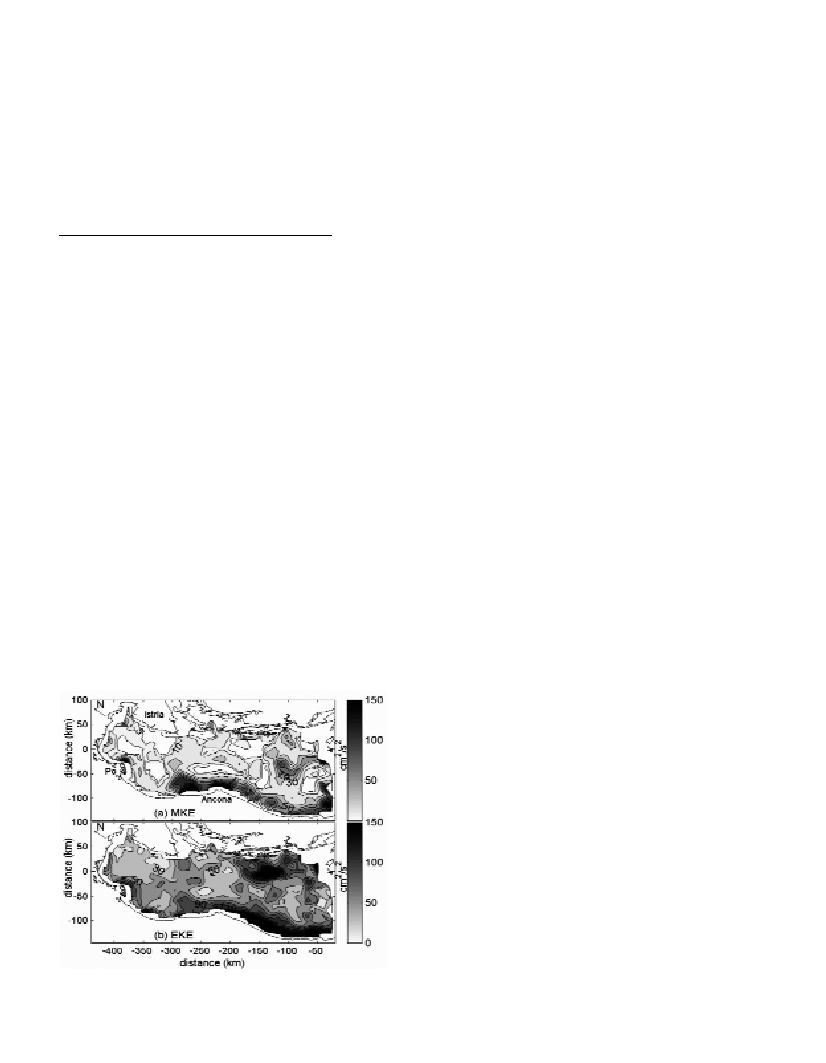Rapp. Comm. int. Mer Médit., 37,2004
147
LAGRANGIAN MEASUREMENTS OF SURFACE CIRCULATION AND KINETIC ENERGY DISTRIBUTION
IN THE NORTHERN ADRIATIC
L.Ursella*, P.-M. Poulain and R. Barbanti
OGS, Borgo Grotta Gigante 42/c, Sgonico, Trieste, Italy - * lursella@ogs.trieste.it
Abstract
The near-surface circulation of the Northern Adriatic is explored using Lagrangian drifting buoy measurements obtained between
September 2002 and October 2003. The data set presents a very good coverage over the studied area and within the measurement period.
The main pathways of the surface waters are defined and the major persistent surface features are described, together with their variability.
Mean kinetic energy (MKE) and eddy kinetic energy (EKE) have been calculated and their spatial and seasonal variability is presented.
Autumn and winter have been found to be the most energetic seasons.
Key-words: Surface Circulation, Energy, Adriatic Sea
Introduction
As part of the ONR-sponsored DOLCEVITA program, more than
120 surface drifters were deployed in the Northern Adriatic starting in
September 2002 to monitor the surface circulation in most areas of the
Northern Adriatic until the end of 2003.
Data and methods
Two versions of the CODE drifter were mainly used: the first one
uses the standard ARGOS telemetry [1] and the second one is
equipped with an additional GPS system, which permits to obtain a
finer resolution both in time and space. Position sampling for GPS-
CODE drifters was programmed at 0.5 or 1 hour intervals. The data
set analyzed in this paper starts on 21 September 2002 and ends on 1
October 2003. Both ARGOS and GPS position data have been quality
controlled, while only ARGOS data have been objectively
interpolated every 2 hours, low-pass filtered (36 hour cut-off) and re-
sampled every 6 hours. Surface velocities have been then calculated
as finite differences of the position data. The Northern Adriatic is well
covered by drifters, with maximum density in the northernmost part
of the basin, due both to a major number of deployments and to a
larger time of residence of drifters in that zone. The total number of
drifter-years for the ARGOS data set is 21.33.
Mean Circulation and Energy
The mean surface ?ow has been calculated for the whole period
from the low-passed data binned in circles of 10 km of radius,
separated by 10 km. The mean surface ?ow field reveals the well-
known persistent features of the Adriatic surface circulation, such as
the Western Adriatic Current (WAC) along the Italian coast, the
Eastern Adriatic Current (EAC) along the Croatian coast that re-
circulates partially around the Middle Adriatic Pit (MAP) and
partially to the south of Istria, and finally the northernmost cyclonic
gyre [1, 2]. A zone of almost no ?ow and no variance is present in
front of the tip of Istria, showing an almost steady pool all over the
period. From the mean ?ow field and variance, the MKE and EKE
have been calculated. They are depicted in Figure1a and 1b,
respectively. The highest values for MKE are found in three zones: i)
in front of the Po river delta, ii) along the Italian coast south of the
delta, and iii) over the MAP. The maximum value, equal to 362
cm
2
/s
2
, is located north of Ancona, where the EKE is the same order
of magnitude (107 cm
2
/s
2
), indicating an equal partition of energy
between the two. On the contrary, the zone south of Ancona is
characterized by the maximum in EKE (about 256 cm
2
/s
2
), indicating
a highly variable zone with current reversals. The already mentioned
zone in front of the tip of Istria shows very low values for MKE (<5
cm
2
/s
2
) with higher values for EKE (about 30 cm
2
/s
2
). Calculating the
ratio EKE/MKE, the lower values are found principally in the zones
of re-circulation of the EAC and along the Italian coast near Ancona.
The temporal distribution of the kinetic energy for the whole basin
shows that autumn and winter are the more energetic seasons, both in
MKE and in EKE. In autumn the MKE is strong along the Italian
coast, probably due to strong Po River out?ow, and around the MAP,
with high values for EKE in front of the Po River and south of
Ancona. In winter, the MKE is particularly strong in the zone between
the tip of Istria and the Italian coast, due to strong Bora wind activity.
In spring large values for the MKE and the EKE are found only to the
south of Ancona. Finally, in summer the MKE is weak all over the
basin, with EKE strong only along the Italian coast south of Ancona.
Conclusions
Direct surface measurements obtained from drifting buoys over one
year, provided the first detailed description of the circulation in the
northern Adriatic. The mean ?ow pattern confirmed the major well-
known features but also evidenced new structures with their spatial
and temporal evolution. The calculated kinetic energy shows an
almost permanent and very energetic zone along the Italian coast.
Energy results maximum in autumn and winter, while it is very weak
in summer.
Acknowledgments. The authors are grateful to all the people who
deployed drifters in the Adriatic Sea. This research was supported by
the Office of Naval Research under grant N000140310291.
References
1-P.-M.Poulain, 2001. Adriatic Sea surface circulation as derived from
drifter data between 1990 and 1999. J. Mar. Syst., 29: 3-32.
2-B.Cushman-Roisin, M.Gacic, P.-M.Poulain and A.Artegiani, 2001.
Physical Oceanography of the Adriatic Sea. Kluwer Academic Publishers,
304 p.
Fig. 1. Mean kinetic energy (a) and eddy kinetic energy (b) in the rotat-
ed Northern Adriatic for the period 21 September 2002 to 1 October 2003.
Only bins with more than 10 observations have been taken into account.

